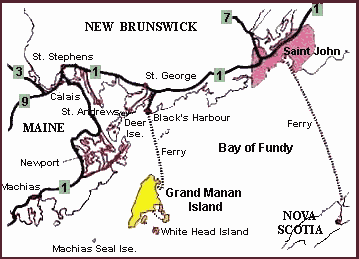
|
Grand Manan is a small island situated in the mouth of the Bay of Fundy. The island's main industries are fishing and aquaculture, and tourism. Aquaculture, namely salmon and scallop, occurs around the island, in and around Duck Island Sound, and on the western side of the idland. The island is also a popular excursion for tourists, who, among other things, are attracted to the naturalness of the island, and the chance to view seabirds, porpoises, seals, and many species of endangered whales. The survey was conduced from July 18-28, 2202 by the University of New Brunswick's Ocean Mapping Group (OMG). The vessel used was the CSL Heron , a 34-foot long hydrographic survey launch on loan to OMG by the Canadian Hydrographic Service. The objective of this survey was to collect Simrad EM3000 multibeam bathymetry and backscatter data. Data was gathered in three different areas along the Eastern and Northern coasts of Grand Manan Island, for three different clients:
|

|
Each of these clients desired information on the surveyed areas for their different research interests:
The data presented here may be subjected to continual reprocessing as part of research within the Ocean Mapping Group. |